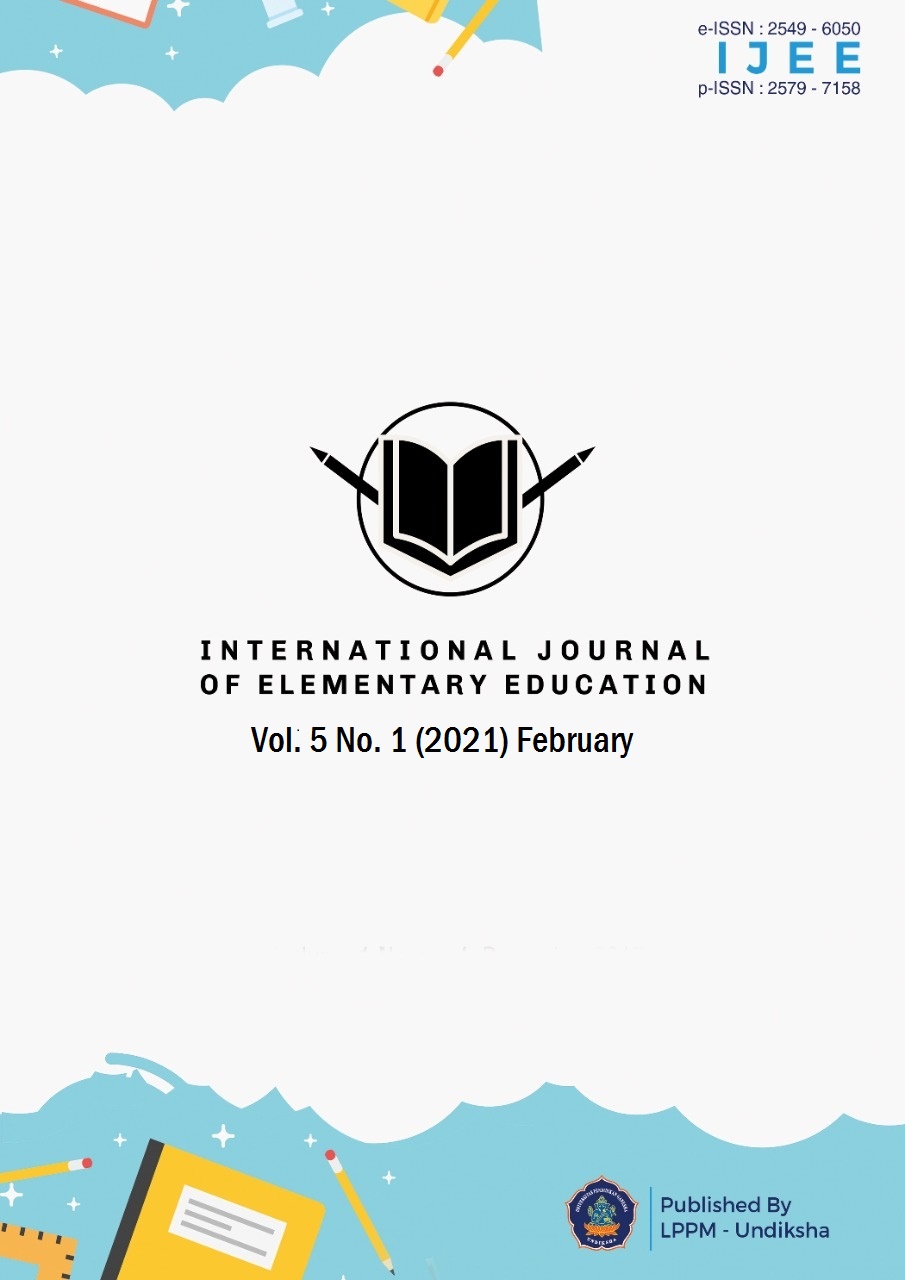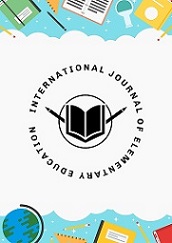Family Environment and Social Sciences Learning Outcomes during the Covid-19 Pandemic
DOI:
https://doi.org/10.23887/ijee.v5i1.32165Keywords:
Family Environment, Social Sciences Learning OutcomesAbstract
This research was conducted basis on many factors that can affect learning success and have an impact on student learning outcomes. This research aims to determine the significant correlation between family environment with social sciences learning outcomes during the COVID-19 pandemic. The research design of this study is ex-post facto research. The population in this study was 57 students and the number of samples was the same as the population, 57 students. Data collection methods in this study used non-test methods, that are questionnaire for the independent variable of the family environment and document recording for the dependent variable social sciences learning outcomes, the data were analysed using simple regression analysis. Based on the results of the analysis with a significance level of 5%, it was found that there was a significant correlation between the family environment and social sciences learning outcomes during the COVID-19 pandemic with rxy = 0,398 and a large contribution of 15,8%. Based on these results it can be concluded that the family environment can affect student learning outcomes especially social sciences subjects.
References
Agot, K., Rusno, R., & Walipah, W. (2019). Analisis Faktor Yang Mempengaruhi Prestasi Belajar Mata Pelajaran Di Smp Negeri 03 Kepanjen. Jurnal Riset Pendidikan Ekonomi, 4(1), 1–6. https://doi.org/10.21067/jrpe.v4i1.3771.
Barsihanor. (2016). Pengaruh Model Pembelajaran Cooperative Learning Teknik Inside Outside Circle Terhadap Hasil Belajar Siswa Bidang Studi IPS MI Darul Mujahidin. Jurnal Madrasah Ibtidaiyah, 1(2), 20–30. https://ojs.uniska-bjm.ac.id/index.php/muallimuna/article/view/382.
Brooman, S., & Darwent, S. (2014). Measuring the beginning: a quantitative study of the transition to higher education. Studies in Higher Education, 39(9), 1523–1541. https://doi.org/10.1080/03075079.2013.801428.
Cho, M. J., & Hong, J. P. (2021). The emergence of virtual education during the COVID-19 pandemic: The past, present, and future of the plastic surgery education. Journal of Plastic, Reconstructive and Aesthetic Surgery, xxxx. https://doi.org/10.1016/j.bjps.2020.12.099.
Christina, L. V., & Kristin, F. (2016). Efektivitas Model Pembelajaran Tipe Group Investigation (Gi) Dan Cooperative Integrated Reading and Composition (Circ) Dalam Meningkatkan Kreativitas Berpikir Kritis Dan Hasil Belajar Ips Siswa Kelas 4. Scholaria : Jurnal Pendidikan Dan Kebudayaan, 6(3), 217. https://doi.org/10.24246/j.scholaria.2016.v6.i3.p217-230.
Crawford, J., Butler-henderson, K., Rudolph, J., Malkawi, B., Glowatz, M., Magni, P. A., & Lam, S. (2020). COVID-19: 20 countries’ higher education intra-period digital pedagogy responses. Journal of Applied Learning & Teaching, 3(1). https://doi.org/10.37074/jalt.2020.3.1.7.
Dahlstrom-Hakki, I., Alstad, Z., & Banerjee, M. (2020). Comparing synchronous and asynchronous online discussions for students with disabilities: The impact of social presence. Computers and Education, 150(June 2019), 103842. https://doi.org/10.1016/j.compedu.2020.103842.
Ding, J., Hermawati, D., & Subakti, H. (2020). Analisis Media Pembelajaran Daring Di Era Pandemi Covid-19 Pada Kelas III SD Negeri 027 Samarinda Ulu. Sistema: Jurnal Pendidikan, 01(02), 16–23. https://doi.org/10.24903/sjp.v1i2.639.
Dwivedi, Y. K., Hughes, D. L., Coombs, C., Constantiou, I., Duan, Y., Edwards, J. S., Gupta, B., Lal, B., Misra, S., Prashant, P., Raman, R., Rana, N. P., Sharma, S. K., & Upadhyay, N. (2020). Impact of COVID-19 pandemic on information management research and practice: Transforming education, work and life. International Journal of Information Management, 55, 102211. https://doi.org/10.1016/j.ijinfomgt.2020.102211.
Fanny, A. M., & Suardiman, S. P. (2013). Pengembangan Multimedia Interaktif untuk Mata Pelajaran Ilmu Pengetahuan Sosial (IPS) Sekolah Dasar Kelas V. Jurnal Prima Edukasia, 1(1), 1. https://doi.org/10.21831/jpe.v1i1.2311.
Handayani, T., Khasanah, H. N., & Yoshinta, R. (2020). Pendampingan Belajar Di Rumah Bagi Siswa Sekolah Dasar Terdampak Covid-19. ABDIPRAJA (Jurnal Pengabdian Kepada Masyarakat), 1(1), 107. https://doi.org/10.31002/abdipraja.v1i1.3209.
Jamil, H. (2014). Pengaruh Lingkungan Keluarga dan Motivasi Belajar Siswa Terhadap Hasil Belajar Akuntansi Siswa Kelas X SMK Negeri 1 Solok Selatan. Jurnal of Economic and Economic Education, 2(2). https://doi.org/10.22202/e conomica.2014.v 2.i2.221.
Jamil, M. M. (2019). Optimalisasi Model ARCS Dalam Pembelajaran Saintifik Untuk Meningkatkan Motivasi Belajar Peserta Didik Pada Peminatan Mata Pelajaran Geografi Di Kelas Matematika Ilmu Alam. IJIS Edu: Indonesian Journal of Integrated Science Education, 1(1), 7–24. https://doi.org/10.29300/ijisedu.v1i1.1401.
Krisna, R. (2020). Korelasi Antara Lingkungan Keluarga dan Gaya Belajar Siswa Terhadap Hasil Belajar IPS. Jurnal Mimbar Ilmu, 25(3). https://doi.org/10.23 887/mi.v25i3.28984.
Lenmita. (2020). Meningkatkan Hasil Belajar IPS Siswa Sekolah Dasar Melalui Penerapan Model Pembelajaran Inkuiri. Jurnal Education and Development, 8(4). https://doi.org/10.37081/ed.v8i4.2186.
Monika. (2018). Pengaruh Lingkungan Keluarga dan Lingkungan Sekolah Terhadap Hasil Belajar Bahasa Indonesia Siswa SMP Negeri 11 Merauke Di Sota Papua. Jurnal Magistra, 5(2). http://ejournal.unmus.ac.id/index.php/magistra.
Purandina, I. P. Y., & Winaya, I. M. A. (2020). Pendidikan Karakter di Lingkungan Keluarga Selama Pembelajaran Jarak Jauh pada Masa Pandemi COVID-19. Cetta: Jurnal Ilmu Pendidikan, 3(2), 270–290. https://doi.org/10.37329/cetta.v3i2.454.
Putria, H., Maula, L., & Uswatun, D. (2020). Analisis Proses Pembelajaran Dalam Jaringan (DARING) Masa Pandemi COVID-19 pada Guru Sekolah Dasar. Jurnal Basicedu, 4(4), 861–870. https://doi.org/10.31004/basicedu.v4i3.416.
Rachmah. (2019). Pengaruh Lingkungan Keluarga dan Fasilitas Belajar pada Prestasi Belajar IPS Siswa Ditinjau dari Motivasi Belajar. Jurnal Pendidikan, 4(9). https://doi.org/10.17977/jptpp.v4i9.12701.
Rahayu, S. (2016). Hubungan Lingkungan Keluarga Terhadap Hasil Belajar Sosiologi Di SMA Negeri 16 Padang. Jurnal Ilmu Sosial Mamangan, 5(1). https://doi.org/10.22 202/mamangan.1929.
Rahayu, Sri. (2016). Hubungan Lingkungan Keluarga Terhadap Hasil Belajar Sosiologi Di SMA Negeri 16 Padang. Jurnal Ilmu Sosial Mamangan, Volume 5(1). https://doi.org/http s://doi. org/10.22 202/mamangan.1929.
Rahayu, T., & Thomas, P. (2017). Pengaruh Kompetensi Profesional Guru Dan Minat Belajar Terhadap Hasil Belajar Siswa Melalui Motivasi Belajar Sebagai Variabel Interrvening Pada Mata Pelajaran Ekonomi. Economic Education Analysis Journal, 6(3), 711–726.
Sadikin, A., & Hamidah, A. (2020). Pembelajaran Daring di Tengah Wabah Covid-19. Jurnal Ilmiah Pendidikan Biologi, 6(02), 214–224. https://doi.org/10.22437/bio.v6i2.9759.
Satrianingrum, A. P., & Prasetyo, I. (2020). Persepsi Guru Dampak Pandemi Covid-19 terhadap Pelaksanaan Pembelajaran Daring di PAUD. Jurnal Obsesi : Jurnal Pendidikan Anak Usia Dini, 5(1), 633. https://doi.org/10.31004/obsesi.v5i1.574.
Slameto. (2010). Belajar dan Faktor-Faktor yang Mempengaruhinya. Rineka Cipta.
Sugiyono. (2017). Metode Penelitian Kuantitatif, Kualitatif, dan R & D. CV Alfabeta.
Sulistiari. (2018). Pengaruh Motivasi, Tipe Belajar, Lingkungan Keluarga, dan Lingkungan Masyarakat Terhadap Hasil Belajar Siswa. Jurnal Pendidikan Ekonomi, Manajemen, Dan Keuangan, 2(1), 57–70. https://doi.org/10.2674 0/jpeka.v 2n1.p57-70.
Wargadinata, W., Maimunah, I., Dewi, E., & Rofiq, Z. (2020). Student’s Responses on Learning in the Early COVID-19 Pandemic. Tadris: Jurnal Keguruan Dan Ilmu Tarbiyah, 5(1), 141–153. https://doi.org/10.24042/tadris.v5i1.6153.
Downloads
Published
How to Cite
Issue
Section
License
Authors who publish with the International Journal of Elementary Education agree to the following terms:
- Authors retain copyright and grant the journal the right of first publication with the work simultaneously licensed under a Creative Commons Attribution License (CC BY-SA 4.0) that allows others to share the work with an acknowledgment of the work's authorship and initial publication in this journal.
- Authors are able to enter into separate, additional contractual arrangements for the non-exclusive distribution of the journal's published version of the work (e.g., post it to an institutional repository or publish it in a book), with an acknowledgment of its initial publication in this journal.
- Authors are permitted and encouraged to post their work online (e.g., in institutional repositories or on their website) prior to and during the submission process, as it can lead to productive exchanges, as well as earlier and greater citation of published work. (See The Effect of Open Access)










